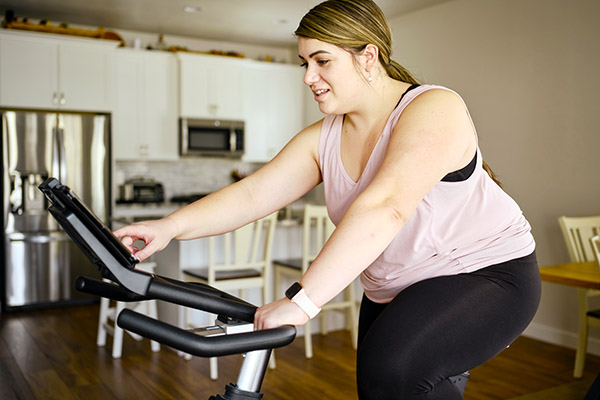What Is the Fat-Burning Zone and Why Should You Care?

If you’ve been fooled by the fat-burning zone on your gym’s cardio machines, don’t feel bad. It’s one of those exercise myths that refuses to go away.
Exercising in the fat-burning zone has been discredited as an effective weight loss strategy by countless fitness magazines, experts, and the American College of Sports Medicine. Yet it’s still with us because it’s partly true.
Yes, the fat-burning zone is real, but it’s not quite helpful for losing significant amounts of fat. And you’re about to find out why.
What Is the “Fat-Burning Zone”?
Your body’s fat burning zone is the heart rate level at which it burns the most calories from fat relative to other forms of fuel. Treadmills, ellipticals, and step machines are common gym contraptions that offer settings like this one, which correspond with exercise intensity.
The fat burning zone setting seemingly takes the guesswork out of identifying the perfect workout intensity at which to achieve the greatest fat loss. Just push a button, keep pace, and be careful not to slip on all of that jettisoned fat as you step off the machine, right?
Wrong. The term and its corresponding setting are fatteningly misleading. To help understand why, let’s take a tour through the different heart rate zones.
The 5 Heart Rate Zones
There are five zones of heart rate activity, which correspond to exertion levels that range from scarcely moving to death by sprinting.

Zone 1: 50-60% of max heart rate (MHR)
This zone governs very light activity. Talking in this zone is easy, with no meaningful increase in your breathing rate.
Zone 2: 60-70% of MHR
Light effort will bring you to this zone, wherein your heart starts to beat slightly faster. You can still talk comfortably, but your breathing becomes heavier.
This is the fat burn zone and, as you can see, there are still three zones remaining, making this an awfully nominal amount of effort when trying to get fat’s attention.
Zone 3: 70-80% of MHR
In this zone, you’re working at moderate effort. Your heart beats harder and faster and, while you can hold a conversation, it takes effort given how hard you’re breathing.
Zone 4: 80-90% of MHR
This is hard effort. You can no longer talk in much more than bursts, and once your heart rate goes above 85 percent of MHR, exercise becomes anaerobic. That’s an important factor in fat loss we’ll discuss later.
Zone 5: 90-100% of MHR
In this zone, you’re exerting maximum effort. Your heart and lungs are now working at full capacity, making talking an impossibility.
The Link Between Exercise Intensity and Fat Burn

Here’s where we tell you why the fat-burning zone exists.
Your body burns calories 24 hours a day regardless of whether you’re moving or not. But when you move — be it fidgeting at your desk, playing tag with your kids, or pounding the pavement in your section of town — you burn more calories, and the extent of that burn is directly related to the intensity of your activity.
Whether those calories come from fat or carbs (in the form of glucose) is also influenced by exercise intensity.
Research shows that low-intensity exercise, like walking or jogging, burns a larger proportion of fat as fuel (hence the “fat-burning zone” on cardio machines). Moderate- to high-intensity exercise (e.g., running, sprint intervals, and circuit training) causes the body to shift primarily to glucose, which can be broken down to supply energy at a faster rate.
Here’s the catch: The fat-burning zone may help you burn a larger proportion of calories from fat as you work out, but high-intensity exercise keeps your metabolism elevated for longer after you finish. This phenomenon is called the afterburn effect, or excess post-exercise oxygen consumption (EPOC).
Think of it in terms of money. Would you rather have 90 percent of 10 dollars, or 20 percent of a hundred?
Low-intensity exercise doesn’t ask much of your body, diminishing the significance of the fat-burning heart rate zone’s disproportionate reliance on fat. Exercising at higher intensities burns less fat as a percentage of fuel expended, but it burns far more fat overall.
The afterburn effect explained
When you exercise, your body toggles between energy systems, broadly the aerobic and anaerobic. Once you go anaerobic (85 percent or more of MHR), your body is no longer able to provide oxygen commensurate with the demands being placed on it. So it keeps making up for that deficit for up to 48 hours afterward, helping you burn more calories (and fat) overall during recovery.
The tragedy of the fat-burning zone is that it misleads people into thinking they don’t have to challenge themselves to see results. That said, always listen to your body — pushing your physical limits won’t feel comfortable, but it shouldn’t be unbearably painful either.
Calculating Your Fat-Burning Heart Rate
Ever confessed your age to an exercise machine? Don’t lie when prompted — your age is used to calculate your fat burning heart rate. If you’re without the necessary gadgetry to determine your precise max heart rate, there’s a handy equation:
208-(0.7 x your age)
From here, you’ll be able to calculate your heart rate in all of the zones by simply multiplying the total from above by the corresponding percentage of MHR.
Fat burning zone chart
| Age | MHR | Fat Burn HR |
| 18-19 | 195 | 117-137 |
| 20-21 | 194 | 116-136 |
| 22 | 193 | 116-135 |
| 23 | 192 | 115-134 |
| 24-25 | 191 | 115-134 |
| 26 | 190 | 114-133 |
| 27 | 189 | 113-132 |
| 28-29 | 188 | 113-132 |
| 30 | 187 | 112-131 |
| 31-32 | 186 | 112-130 |
| 33 | 185 | 111-130 |
| 34-35 | 184 | 110-129 |
| 36 | 183 | 110-128 |
| 37 | 182 | 109-127 |
| 38-39 | 181 | 109-127 |
| 40 | 180 | 108-126 |
| 41-42 | 179 | 107-125 |
| 43 | 178 | 107-125 |
| 44-45 | 177 | 106-124 |
| 46 | 176 | 106-123 |
| 47 | 175 | 105-123 |
| 48-49 | 174 | 104-122 |
| 50 | 173 | 104-121 |
| 51-52 | 172 | 103-120 |
| 53 | 171 | 103-120 |
| 54-55 | 170 | 102-119 |
Workout Tips for Getting Into the (Real) Fat-Burning Zone

Next time you’re on a cardio kick, use these tips to get more fat-burning benefits from your workouts.
1. Use the manual setting on workout machines
You can still use the zone settings on a treadmill or stationary bike as a guide, but don’t zone out after that. Assess how you feel during your workout. Is it too hard? Too easy?
Manually change speed and elevation to challenge yourself. Hint: If you can carry a conversation while moving, bump up the intensity!
2. Include resistance training
Steady-state cardio shouldn’t be your only strategy if you want to optimize fat loss.
Indeed, strength training is an even more effective strategy in that regard, because it keeps your metabolism elevated for longer after you work out, helping you burn more calories overall.
And the benefits don’t stop there — especially if you’re a cardio junkie, as resistance training can help increase running speed, economy, and power output.
What’s more, studies show that it can increase time to exhaustion and reduce your risk of injury. So try replacing at least one cardio session per week with a strength session.
3. Try high-intensity interval training (HIIT)
HIIT is an exercise strategy in which you alternate periods of intense activity (80 to 90 percent of your maximum effort, or heart rate zone 4) with less intense periods of rest.
Circuit training, sprint drills, and stadium stair running are all examples of HIIT. You’ll also find it in most of the workout programs on Beachbody On Demand.
The idea is that you repeatedly push your body to its limits, focusing on workout density and intensity rather than duration.
Studies show that HIIT causes the greatest increase in “excess post-exercise oxygen consumption” (EPOC), which is the amount of oxygen required to restore the body to its normal resting state.
Here’s why that matters to you: The higher your EPOC, the more calories you’ll burn post-workout.
Although HIIT is the most effective form of exercise for losing weight, it’s not always the best choice for beginners. If you’re new to exercise, or are getting back into it after a long absence, save HIIT for when you’ve built a solid fitness foundation. That way, you can optimize fat loss without increasing your risk of overtraining or injury.
